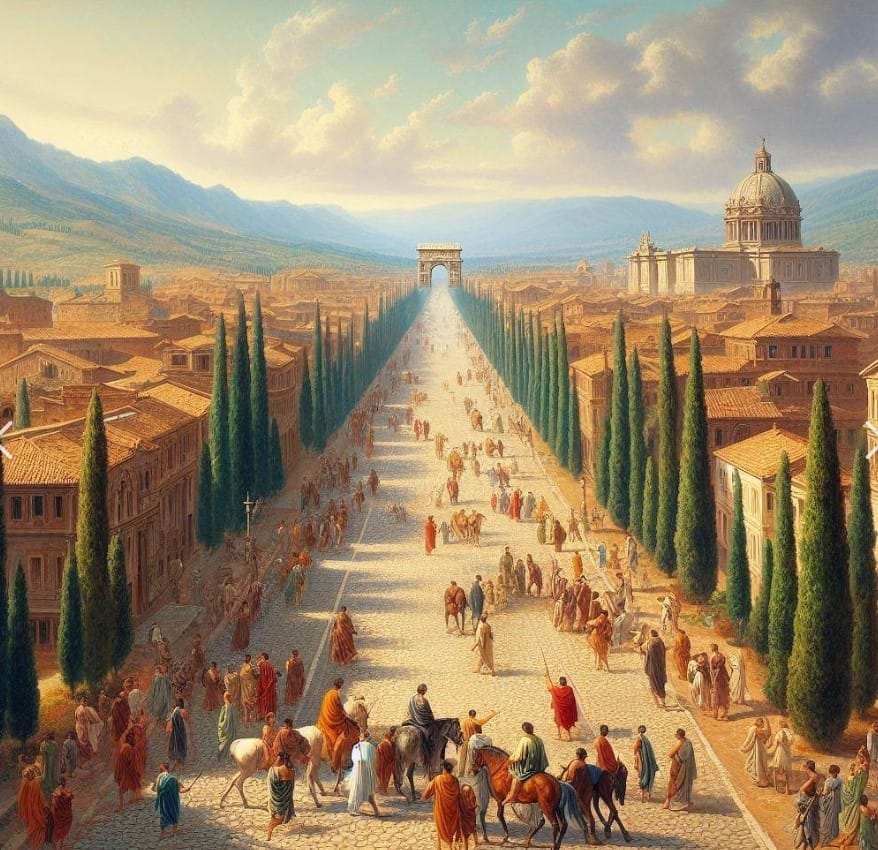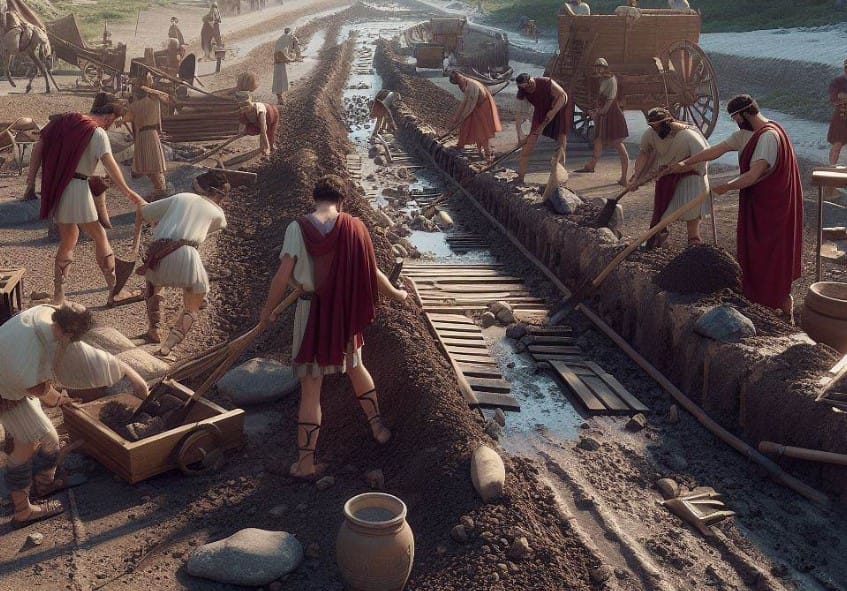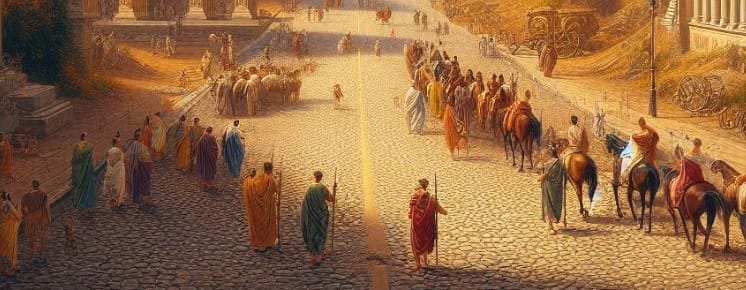Explore the History and Significance of Roman Roads
Last Updated on December 1, 2023 by Vladimir Vulic
 explore the history and significance of roman roads 5
explore the history and significance of roman roads 5
Welcome to our exploration of Roman roads, a fascinating aspect of ancient Roman infrastructure. The Roman Empire is renowned for its advanced engineering and architecture, and the extensive network of roads is no exception. These roads played a crucial role in shaping the empire’s success, from military might to economic growth.
The Efficiency and Design of Roman Roads
Roman roads were a testament to the remarkable engineering skills and ingenuity of the ancient Romans. These roads were not only efficient but also designed with speed of travel in mind. Land surveyors meticulously charted the most direct routes between destinations, resulting in remarkably straight roads that often went uphill and included bridges and tunnels to overcome geographical obstacles.
The construction techniques of Roman roads were truly impressive. The roads were engineered with multiple layers to ensure durability and flatness. They were made of leveled earth, crushed rocks, and gravel cemented with lime mortar. The surface layer was constructed using blocks made from various materials such as gravel, pebbles, iron ore, or volcanic lava.
Furthermore, Roman roads were built with crowns and drainage systems to ensure easy water flow. They even featured mile markers for travel guidance, showcasing the attention to detail in their design. The efficiency and quality of Roman road construction are still evident today in the remnants of ancient roads that have stood the test of time.

Roman roads were a marvel of engineering, showcasing the Romans’ commitment to efficient infrastructure. Their design and construction techniques allowed for swift travel and facilitated the movement of troops and supplies throughout the vast Roman Empire.

The Efficiency and Design of Roman Roads
FeaturesBenefitsStraight routesQuick travel between destinationsBridges and tunnelsOvercoming geographical obstaclesMultiple layers of constructionDurability and flatnessVarious materials usedAdaptability to different environmentsMile markersTravel guidance and distance measurement
Roman roads were not only efficient and durable but also played a vital role in the success of the Roman Empire. The efficiency of travel and the well-designed construction techniques of these roads contributed to the rapid expansion and administration of the vast territories under Roman rule.
The Role of Roman Roads in Trade and Communication
Roman roads played a crucial role in facilitating trade and communication throughout the vast Roman Empire. The road system, with its efficient transportation network, allowed for the easy movement of goods and people, promoting economic growth and cultural exchange. Travelers and merchants could rely on the well-developed network of post houses and roadside inns for rest and resupply.
The frequent horse changing stations and roadside hotels provided essential services for travelers, making long journeys more comfortable and efficient. The advantages of the Roman road system allowed for the swift and reliable transportation of goods, enabling the exchange of commodities across the Empire. This contributed to the economic development of various regions and the diffusion of different cultures within the Roman Empire.
Furthermore, the road system indirectly helped unify the diverse cultures and regions within the Empire. By connecting various settlements, the Roman roads fostered a sense of connectedness and facilitated the spread of ideas, innovations, and cultural practices. This cultural exchange played a vital role in shaping the identity of the Roman Empire and promoting a sense of coherence and shared values among its inhabitants.

Advantages of Roman Road System
“The Roman road system allowed for the rapid movement of troops and supplies, ensuring that even the most remote areas of the Empire could be quickly reinforced or supplied in times of emergency.” – Roman historian, Marcus Antonius
- The efficient transportation network of Roman roads facilitated trade and economic growth.
- The well-developed network of roadside inns and post houses provided essential services for travelers, ensuring their comfort and safety.
- The road system played a vital role in the diffusion of cultures and ideas within the Roman Empire, contributing to the development of a shared identity.
- The Roman road system allowed for the rapid movement of troops and supplies, ensuring the security and stability of the Empire.
Overall, the Roman road system served as a crucial infrastructure that facilitated trade, communication, and cultural exchange throughout the vast territories of the Roman Empire. The advantages of this well-developed network played a significant role in promoting economic growth, unifying diverse cultures, and maintaining the security and stability of the Empire.
Advantages of Roman Road SystemEfficient transportation networkWell-developed roadside inns and post housesFacilitated cultural exchangeRapid movement of troops and supplies
Roman Roads: Security and Maintenance
Roman roads were not only well-built but also well-protected. Stationarii and beneficiarii, special detachments of imperial troops, patrolled the roads, ensuring the safety of travelers and helping to maintain the roads’ functionality. These soldiers manned police posts and watchtowers along the road network, guiding vulnerable travelers and collecting tolls or taxes when necessary.
The security measures implemented by the Romans helped protect travelers from the threats posed by bandits and other criminals. The presence of the stationarii and beneficiarii created a sense of order and deterred potential wrongdoers from targeting the roads. Additionally, the soldiers’ regular patrols allowed them to respond quickly to any incidents or emergencies that occurred along the roads.
Maintenance of Roman roads was also a crucial aspect of their longevity and usability. Despite their sturdy construction, the roads required regular upkeep to ensure their functionality. Historical records mention repairs and renovations carried out by various individuals, including local communities, wealthy benefactors, and even emperors themselves. Mile markers placed along the roads served as a record of these maintenance efforts, documenting the individuals responsible for the upkeep of specific sections of the road network.
Overall, the combination of robust security measures and regular maintenance ensured that Roman roads remained safe and functional throughout the Roman Empire’s vast territories. These roads not only provided efficient transportation but also played a significant role in maintaining the cohesion and stability of the empire.
Table: Roman Road Security and Maintenance
Security MeasuresMaintenance Activities– Patrols by stationarii and beneficiarii troops– Regular repairs and renovations– Police posts and watchtowers along the road network– Mile markers documenting maintenance efforts– Collection of tolls and taxes– Involvement of local communities, benefactors, and emperors
The Mapping and Documentation of Roman Roads
The Romans were meticulous in their mapping and documentation of the road network. One of the most valuable sources of information about the Roman transit system is the Peutinger Table, a 13th-century copy of a Roman map from the 4th century A.D. This detailed atlas provides a fascinating glimpse into the extensive Roman road network, showcasing major routes, distances between cities, landmarks, and even the names of those responsible for road construction and maintenance.
The Peutinger Table was likely used as a field guide for government officials or displayed in imperial palaces, highlighting the importance of the road system in Roman administration. The map is an invaluable resource for historians and archaeologists in understanding the extent and organization of the Roman road network.
“The Peutinger Table offers a unique perspective on the vastness and complexity of the Roman road system. It provides a detailed snapshot of the infrastructure that connected the farthest reaches of the Roman Empire.”
In addition to the Peutinger Table, other ancient sources, such as itineraries and milestones, offer further insights into the Roman road network. These documents recorded the distances between cities and the significant landmarks along the way. The Romans were thorough in their record-keeping, ensuring that their road network could be efficiently maintained and traversed.
The Durability and Legacy of Roman Roads
Roman roads were built to withstand the test of time, and their durability is a testament to the engineering prowess of the ancient Romans. These roads were constructed with multiple layers of materials, including earth, crushed rocks, and gravel cemented with lime mortar. The surface layer, made up of blocks made from various materials such as gravel, pebbles, iron ore, or volcanic lava, was designed to withstand heavy usage and provide a smooth and sturdy surface for travelers.
The enduring legacy of Roman roads can still be seen today, with many of them serving as the foundation for modern highways. These ancient roads have stood the test of time and have not only influenced the development of road systems in subsequent civilizations but also continue to carry traffic, showcasing their remarkable durability. These roads were not only practical but also played a significant role in shaping the world we live in today.
The construction and durability of Roman roads were unparalleled until the 19th century, and their legacy can be seen in the ancient bridges, viaducts, and tunnels that are still standing today.
The engineering techniques used in the construction of Roman roads were far ahead of their time. The meticulous attention to detail, strong foundations, and well-designed drainage systems ensured that these roads could withstand the elements and heavy usage. The Romans’ focus on durability and functionality has left a lasting impact on road construction methods that is still admired and studied to this day.
Key Features of Roman RoadsExamplesStraight and Direct RoutesAppian Way, Via AugustaMultiple Layers for DurabilityEmperor’s Road, Via DomitiaBridges and ViaductsPonte Milvio, Pont du GardTunnelsCorbières Tunnel, Aemilian Way Tunnel
The legacy of Roman roads extends beyond their physical structures. These roads played a crucial role in the expansion and administration of the Roman Empire, facilitating trade, communication, and the movement of troops. They were not only a means of transportation but also a symbol of Roman power and dominance. The efficiency and durability of Roman roads allowed the Empire to maintain control over its vast territories and contributed to the unification of diverse cultures under Roman rule.
The Influence of Roman Roads on Modern Infrastructure
The influence of Roman roads can still be seen in modern infrastructure and road design. The Romans’ emphasis on efficiency, durability, and straight routes has shaped the development of road systems worldwide. The techniques used by the Romans, such as layered construction, proper drainage, and use of durable materials, are still employed in road construction today. Roman roads serve as a reminder of the ingenuity and engineering skills of the ancient world and continue to inspire modern engineers and architects.
Expansion of Roman Roads Beyond Italy
The impressive network of Roman roads that originated in Italy eventually expanded throughout the vast territories of the Roman Empire. These roads played a vital role in facilitating trade, communication, and the administration of the Empire. As the Romans conquered new lands, they constructed roads that connected regions from Britain to Syria, making travel and transportation more efficient across these vast territories.
The expansion of the Roman road system beyond Italy had a significant impact on the Roman Empire. It allowed for the rapid deployment of troops, making it easier to maintain control over newly conquered territories. The road network also facilitated the transportation of essential supplies, enabling the Empire to sustain its military campaigns and consolidate its rule. Moreover, the roads promoted cultural exchange and trade, fostering economic growth and unity within the Empire.
The expansion of Roman roads abroad demonstrated the engineering prowess and ambition of the Romans. These roads became as famous and well-traveled as those in Rome itself, showcasing the influence and reach of the Roman Empire. The efficiency and durability of the Roman road system played a crucial role in the growth and success of the Empire, leaving a lasting legacy that influenced the development of road systems in subsequent civilizations.
To illustrate the extent of the Roman road expansion, the table below provides examples of key Roman roads constructed beyond Italy, their destinations, and the regions they connected:
Roman RoadDestinationsConnected RegionsVia AugustaCadiz (Spain) to RomeSpain, Gaul, ItalyVia Claudia AugustaDonauworth (Germany) to Altinum (Italy)Germany, Switzerland, Austria, ItalyWatling StreetLondon to Wroxeter (England)EnglandVia EgnatiaDyrrhachium (Albania) to Byzantium (Turkey)Greece, Albania, North Macedonia, TurkeyAppian WayRome to Brundisium (Italy)Italy
Image:
Sources:
- “Roman Roads.” Ancient History Encyclopedia, www.ancient.eu/Roman_Roads/.
- Starr, Chester G. “The Roads of the Romans.” The Geographical Review, vol. 3, no. 5, 1917, pp. 389–408. JSTOR, www.jstor.org/stable/207785.
Road Design and Materials Used
Roman roads were renowned for their efficient design and use of durable materials, allowing for the smooth flow of traffic throughout the Roman Empire. The design of these roads followed a standardized width of approximately 4.2 meters, providing enough space for two wheeled vehicles to pass each other with ease.
When it came to construction materials, Roman engineers employed a combination of gravel, lime, and various types of stones. The roads were built in layers, starting with a foundation of leveled earth and crushed rocks, which provided stability. On top of this foundation, a layer of gravel cemented with lime mortar was added, offering a sturdy base for the final surface layer.
The surface layer of Roman roads was constructed using blocks made from materials such as gravel, pebbles, iron ore, or volcanic lava. These blocks were carefully laid to ensure a smooth and flat surface for easy travel. Drainage systems were incorporated into the road design, allowing for the efficient flow of water to prevent erosion and maintain the road’s integrity.
Overall, the combination of meticulous road design and the use of durable construction materials contributed to the long-lasting nature of Roman roads. Many of these roads remained in use for centuries and continue to influence modern road systems.
Table: Roman Road Construction Materials
LayerMaterials UsedFoundationLeveled earth, crushed rocksMiddle LayerGravel cemented with lime mortarSurface LayerBlocks made from gravel, pebbles, iron ore, or volcanic lava
The construction materials used in Roman road construction ensured a sturdy and durable road surface. The foundation layer of leveled earth and crushed rocks provided a stable base, while the middle layer of gravel cemented with lime mortar added strength. Finally, the surface layer, consisting of carefully placed blocks made from various materials, created a smooth and flat surface for travel.
The extensive use of these materials and the meticulous road design remain a testament to the engineering skills and ingenuity of the ancient Romans. Their road network continues to inspire awe and admiration, showcasing the lasting impact of Roman civilization on the world.
Bridges, Viaducts, and Tunnels of the Roman Road Network
The Roman road network was a marvel of engineering, and it included impressive architectural structures such as bridges, viaducts, and tunnels. These elements were strategically designed to create the shortest routes possible between two points, allowing for efficient travel throughout the Roman Empire.
Roman road bridges were constructed with arches using durable materials and sturdy construction techniques. These bridges were not only functional but also aesthetically pleasing, with their elegant arches spanning rivers and valleys. Many of these bridges have stood the test of time and are still in use today, serving as a testament to the ingenuity of Roman engineers.
“The Roman bridge is not just a structure; it is a work of art. Its arches gracefully soar over the water, connecting people and cultures.” – Roman architect Quintus Vitruvius
Tunnels were another integral feature of the Roman road network, allowing for the avoidance of lengthy detours. Constructing these tunnels was no easy task, as they often had to be carved through solid rock. The precision and skill required to create these tunnels demonstrate the ingenuity of Roman engineers.
BridgesViaductsTunnelsBridge of Alcántara (Spain)Aqua Marcia (Rome)Tunnel of Eupalinos (Samos)Ponte Milvio (Italy)Segovia Aqueduct (Spain)Via Appia Antica (Italy)Ponte Sant’Angelo (Italy)Ponte di Tiberio (Italy)Anio Novus (Rome)
The Roman road network’s bridges, viaducts, and tunnels were not only engineering marvels but also crucial components of an efficient and effective transportation system. They allowed for the seamless movement of goods, people, and culture throughout the vast Roman Empire, leaving a lasting legacy that can still be admired today.
Conclusion
Roman roads were an extraordinary engineering feat that left a lasting mark on history. The significance of these roads cannot be overstated, as they played a crucial role in the military might, economy, and cultural cohesion of the Roman Empire.
With their expert design and construction, Roman roads enabled the swift movement of troops and supplies, ensuring the Empire’s security and quick response to emergencies. These roads also facilitated trade and communication, allowing goods and people to move easily throughout the vast territories of the Empire.
The durability of Roman roads is truly remarkable, with many roads remaining in use for centuries and still exerting influence on modern road systems. The legacy of Roman road engineering can be seen in the bridges, viaducts, and tunnels that have stood the test of time, showcasing the ingenuity and skill of the ancient Romans.
In conclusion, the historical significance of Roman roads is undeniable. They were not just a means of transportation but a symbol of Roman power and ingenuity. The network of Roman roads stands as a testament to the achievements of the ancient Romans and their impact on the world we live in today.
Related Post
A shocking documentary proves that mermaids do exist
SHOCKING Revelation: Thuya, Mother of Queen Tiye, Was the Grandmother of Akhenaten and Tutankhamun—What Ancient Egyptian Secrets Did She Leave Behind?
Breaking News: Astonishing Discoveries at Karahan Tepe Confirm an Extraterrestrial Civilization is Hiding on Earth, and NO ONE Knows!
Breaking News: Researchers FINALLY Discover U.S. Navy Flight 19 After 75 Years Lost in the Bermuda Triangle!
NASA’s Secret Investigation: Uncovering the Astonishing Mystery of the UFO Crash on the Mountain!
Explosive UFO Docs LEAKED: Startling Proof That Aliens Ruled Ancient Egypt!
